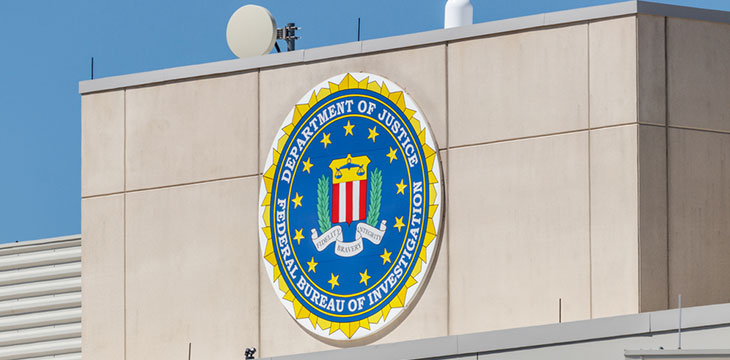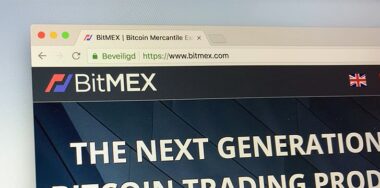U.S. authorities are reportedly split on when to file money laundering charges against the Binance digital assets exchange, which is arguing that taking it down could bring down the whole ‘crypto’ house of cards.
On Monday, Reuters reported that officials at the U.S. Department of Justice (DOJ) are preparing charges of unlicensed money transmission, money laundering conspiracy, and criminal sanctions violations against Binance. But no decision on when to file these charges has been made, partly due to the Byzantine pecking order of U.S. law enforcement bureaucracy.
Reuters reported that prosecutors from three different DOJ branches—the U.S. Attorney’s Office for the Western District of Washington, the Money Laundering and Asset Recovery Section (MLARS), and the National Cryptocurrency Enforcement Team (NCET)—are involved in the probe.
The investigation, which focuses on actions taken by Binance boss Changpeng ‘CZ’ Zhao and other key executives, began in 2018 at the Washington State office. Reuters’ sources claim the DOJ was pushed to act after tracing criminals’ use of Binance to move illicit funds, after which the Washington agents teamed up with MLARS and the Internal Revenue Service’s Criminal Investigation (IRS-CI) unit.
Investigators took notice of Binance’s public claims that, at the time of its 2017 launch, nearly one-third of its users were based in the U.S. Despite this significant U.S.-based volume, Binance failed to register with the Department of the Treasury or implement rigorous anti-money laundering (AML) programs, as required under U.S. law.
In 2018, CZ became aware of the DOJ’s interest in Binance’s operations, which led to the ‘Tai Chi’ strategy of setting up a separate, more compliant U.S.-focused exchange as a way to “insulate” the dot-com mothership from unwanted American scrutiny. CZ also instructed staff to utilize encrypted messaging services that automatically deleted users’ messages after a time as a means of minimizing the likelihood of U.S. authorities gaining access to compromising internal communications.
In December 2020, when attorneys at the DOJ’s Washington office and MLARS requested internal communications from CZ and 12 other Binance execs, one of the dozen individuals reportedly made a ‘panicked’ call to an advisor because the records sought by the DOJ had been erased. The vanished records reportedly included CZ making financial decisions on behalf of the Binance.US exchange, which CZ and Binance had claimed was a distinct entity that made its own decisions.
In response to the probe, Binance belatedly began beefing up its legal department, then headed up by Jared Gross, who was sorely lacking in experience dealing with regulators. But it wasn’t until 2021 that Binance finally implemented something approaching a proper AML program, including halting the process of allowing individuals to open an account using just an email address to satisfy know-your-customer (KYC) requirements.
Attorneys at the DOJ’s Washington office and the NCET are reportedly convinced they have enough information to prosecute CZ and other Binance execs, but the MLARS leadership had been dragging its heels. However, in October, MLARS appointed Brent Wible as its new chief. Wible is a former prosecutor in the DOJ’s Southern District of New York office with a well-earned reputation for targeting financial criminals.
On the other side, Binance has engaged Kendall Day, a partner at Gibson Dunn and a former MLARS boss, to handle the DOJ’s investigation. In meetings with the DOJ’s Washington office, Day has reportedly floated the idea that the probe could be resolved out of court if Binance agreed to pay (presumably hefty) financial penalties.
These aren’t the crooks you’re looking for
Binance initially responded to the Reuters report via its official Twitter feed, claiming that the media outlet was “attacking our incredible law enforcement team” that has “made crypto more secure for all of us.”
Reuters has it wrong again.
Now they're attacking our incredible law enforcement team. A team that we're incredibly proud of – they've made crypto more secure for all of us.
Here’s the full statement we sent the reporter and a blog about our remarkable law enforcement team.
— Binance (@binance) December 12, 2022
Binance doubled down on this approach in a more formal response to the Reuters report written by Tigran Gambaryan, its VP of Global Intelligence and Investigations. Gambaryan, a former IRS-CI agent, claimed that Binance had built “the industry’s most robust security and investigations team” that was “possibly even the strongest in the entire financial sector.”
CZ personally tweeted “Ignore FUD” (fear, uncertainty, and doubt) to his nearly 8 million followers, then amplified a follower’s suggestion that the “paid fud fest” was done at the behest of execs who headed up the collapsed FTX exchange. CZ claimed that “Now we really know…” who allegedly ‘paid’ for a July report by Bloomberg that made similar claims regarding Binance’s legendary disdain for the rule of law.
CZ’s dig at FTX played on an Axios report from late last week that FTX had secretly funded crypto news site The Block. That report led to the resignation of The Block’s CEO Michael McCaffrey, who reportedly received $16 million from FTX that he used to purchase an apartment in the Bahamas, FTX’s former corporate home.
These are typical tactics from CZ and Binance, who routinely dismiss all criticism as FUD while claiming that they—seemingly alone among everyone/everything else in the digital asset space—lead the way in regulatory compliance and helping blind senior citizens cross busy streets. It’s hard not to think that Binance’s efforts played a role in Merriam-Webster selecting ‘gaslighting’ as its word of the year.
Proof of chutzpah
Recent examples of Binance gaslighting the public include its heavily-promoted publication of an attestation of its ‘proof of reserves’ of its customers’ BTC holdings by South African auditing firm Mazars. While CZ has touted the attestation as a formal audit, Mazars defines its report as being based on ‘Agreed-Upon Procedures’ (AUP), which involves “performing the procedures that have been agreed with Binance.”
Furthermore, an AUP engagement “is not an audit, review or other assurance engagement.” Nor does it involve “obtaining evidence for the purpose of a practitioner expressing an opinion or an assurance conclusion in any form.” The report goes on to state that had Mazars “performed additional procedures, other matters might have come to our attention that would have been reported.”
In other words, Mazars merely examined figures provided by Binance and reported that it had done so, without any assurance that the figures were proof of, well, anything. John Reed Stark, a former enforcement agent at the U.S. Securities and Exchange Commission (SEC), tweeted that Binance’s audit claims were “how I define ‘red flag.”
Binance’s “proof of reserve” report doesn’t address effectiveness of internal financial controls, doesn’t express an opinion or assurance conclusion and doesn’t vouch for the numbers. I worked at SEC Enforcement for 18+ yrs. This is how I define “red flag. https://t.co/6oEqmArjS9
— John Reed Stark (@JohnReedStark) December 11, 2022
BUSteD
Then there’s BUSD, the stablecoin that Binance developed with Paxos. At the time of BUSD’s launch in 2019, CZ referred to it as “our native stablecoin.” But as BUSD came under greater scrutiny, CZ’s narrative shifted to the claim that the U.S.-based Paxos is the one that issues BUSD, while Binance “lend branding support only.”
However, the Binance Academy’s BUSD page clarifies that while Paxos does indeed issue BUSD on the Ethereum blockchain, Binance also mints BUSD tokens on its in-house BNB Chain (formerly the Binance Smart Chain). Binance insists that each of these Binance-Peg BUSD tokens “corresponds to a BUSD token held in reserve by Binance” but warns that these tokens aren’t “regulated by the New York State Department of Financial Services” as is the case with Paxos-issued BUSD.
Last month, CZ touted the fact that Binance’s ‘industry recovery initiative’ was heavily reliant on its in-house tokens BUSD and BNB. Two-thirds of the original billion dollars in this fund was comprised of BUSD and BNB, while the additional billion CZ announced would be allocated to the fund was entirely made up of BUSD.
The wallet address CZ cited for the BUSD allocation was on the BNB/BSC chain, meaning it’s not the U.S.-regulated Paxos version of BUSD. As with CZ’s Binance.US claims, the intent appears to bathe in the positive light reflected by other entities while obscuring the fact that said light had to bounce off several strategically positioned mirrors before landing on Binance.
Yesterday, #Binance allocated ANOTHER $1 billion to the industry recover initiative. All in BUSD.
— CZ 🔶 Binance (@cz_binance) November 25, 2022
The league of extraordinarily crooked gentlemen
In the wake of FTX’s collapse, CZ has been busy trying to claim the ‘crypto good guy’ role formerly occupied by FTX’s disgraced owner Sam Bankman-Fried. This awkward personal rebranding is further complicated by the widespread belief that CZ poured fuel on FTX’s dumpster fire by publicly announcing his plan to dump over half-a-billion dollars of FTX’s in-house FTT token, sparking a wave of withdrawal requests that CZ knew FTX couldn’t honor.
Prior to FTX’s collapse, the exchange and its affiliated market-maker Alameda Research had been among the largest recipients of the Tether stablecoin that keeps much of the shady ‘crypto’ industry afloat. But so great was the need for FTX/Alameda to raise some quick cash that SBF allegedly tried to short Tether, a strategy that didn’t endear SBF to CZ.
Binance is also among the top exchange recipients of Tether and, with FTX now in mothballs, has enjoyed a boost in its already dominant market share. With so much of Binance’s customer base located in crypto-antagonistic markets, Tether plays a key role in ensuring that Binance customers—particularly those looking to avoid the prying eyes of law enforcement—can fund their accounts without relying on local banks.
Last week, the New York Times reported on an online conversation that CZ and SBF had on November 10, the day before FTX filed for bankruptcy protection. The messages were posted to ‘Exchange coordination,’ a group chat on the Signal private messenger app. The Wall Street Journal, which received copies of the same messages, said the chat also included Jesse Powell, co-founder of the U.S.-based Kraken exchange, Tron founder Justin Sun and Tether’s chief technology officer Paolo Ardoino.
Ardoino had reportedly initiated complaints about SBF’s efforts to ‘de-peg’ Tether from its 1:1 ratio with the U.S. dollar. CZ issued a “Stop now, don’t cause more damage” warning to SBF, who denied the shorting allegation, saying, “I have made a number of mistakes over the past year, but this is not one of them.” CZ simply reiterated his view that SBF needed to “stop doing everything. Put on a suit and go back to D.C. and start to answer questions.”
Leaving aside CZ’s evident concern that SBF’s actions might encourage others to try to short Tether and possibly derail the crypto cartels’ gravy train, the notion that the world’s leading exchanges all ‘coordinate’ their activity outside the public eye—frankly, we’re impressed they showed the restraint not to name the chat ‘Exchange collusion’—should demolish any lingering faith the masses might have that they’re getting a fair shake on exchanges such as Binance.
Remember that Binance was one of the exchanges that in 2019 actively colluded to delist BSV based on their opposition to Dr. Craig Wright, author of the Bitcoin white paper. Wright maintained that BSV, unlike all of the function-free gambling tokens that followed, was intended to facilitate cost-effective peer-to-peer electronic cash transactions and immutable data storage, not fuel get-rich-quick schemes.
As BSV was the only protocol that remained true to Bitcoin’s original design, knowledge of its existence needed to be suppressed. But just as CZ is learning how hard it is to keep a good idea hidden forever, he’s finding that it’s equally hard to keep your bad behavior swept under the rug.
Among the arguments Binance’s legal advocates are reportedly using to convince the DOJ not to criminally charge Binance/CZ is that doing so would further destabilize the overall digital asset sector just as it’s reeling from a thousand other self-inflicted wounds. If ‘financial criminals are counting on us’ is the best argument Binance has, CZ will likely need more than Tai Chi to fend off any amorous cellmates.
Follow CoinGeek’s Crypto Crime Cartel series, which delves into the stream of groups—from BitMEX to Binance, Bitcoin.com, Blockstream, ShapeShift, Coinbase, Ripple,
Ethereum, FTX and Tether—who have co-opted the digital asset revolution and turned the industry into a minefield for naïve (and even experienced) players in the market.
New to blockchain? Check out CoinGeek’s Blockchain for Beginners section, the ultimate resource guide to learn more about blockchain technology.








